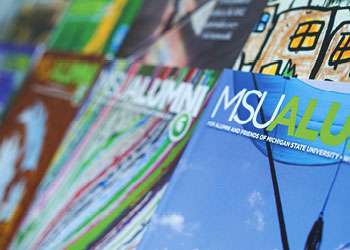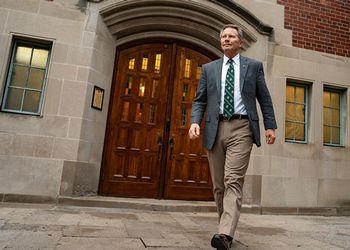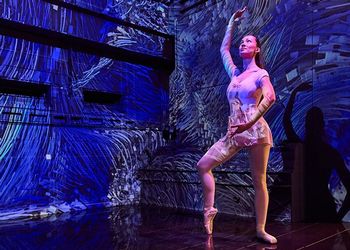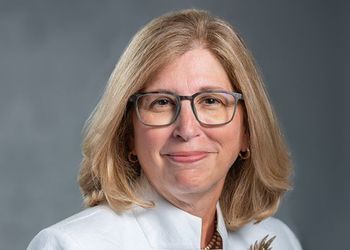Sports: The Perles Era Ends in 1994

In 12 years as head coach, George Perles built a solid football program marked by both triumphs and turmoil. Tuesday, Nov. 8, 14 television crews and untold media scribes jammed in the Duffy Daugherty Building. When President Peter McPherson declared that George Perles 'will not coach next season,' an electric twinge swept across the room. It finally happened. The George Perles era--12 years of glorious triumphs as well as turmoil--had come to an end.
The next weekend, Perles rallied MSU to an emotional, come-from-behind 42-30 win against Purdue--his 'last hurrah' in Spartan Stadium. Then came an expected loss to Penn State, winner of the Big Ten title and one of the nation's two best teams according to the polls. The 1994 season's final 5-6 tally clearly fell short of McPherson's expectation of an 'outstanding season.'
Just three months earlier, though, anticipation soared among coaches, fans and alumni. Although 1993 had ended on a down note, with bowl losses in Japan and Memphis, this year's team was bolstered by the addition of Hank 'Doctor of Defense' Bullough, an 18-year NFL veteran who agreed to return to his alma mater as defensive coordinator. MSU recruited JUCO All-American Tony Banks, a mobile quarterback with a rifle arm. Protecting him was a massive, senior- dominated offensive line averaging around 300 pounds.
The smell of roses in early fall, however, dampened with an opening loss at Kansas. Banks' collegiate debut proved shaky, while the revamped defense could not contain the option. But hopes rose the next week when MSU almost upset Notre Dame. The Spartans dominated the first half, but a poor second half effort allowed the Fighting Irish to escape East Lansing 21-20. After a 45-10 blowout of Mid-American Conference's Miami-Ohio, MSU staged perhaps its top effort of the season against defending Rose Bowl champs Wisconsin. As the overcast sky cleared and the sun peered out, the Homecoming crowd went delirious as MSU delivered some of the biggest hits ever heard in Spartan Stadium. In its Big Ten opener, MSU had shocked the Badgers 29-10 on national television. Would this be our year? fans from coast to coast wondered. The next three weeks they found out with gong-like monotony: noooo, noooo, noooo. First, Michigan demolished the Spartans in Ann Arbor, gaining yardage seemingly at will. A close home loss against Ohio State was aggravated by the loss of Mill Coleman, MSU's pivotal leader and 'go to' player. Then came the coup de grace. Decimated by injuries, Iowa was down to a fourth-string quarterback with an injured throwing arm. Not even pink lockers could rescue Hayden Fry, or so it seemed. But some razzle dazzle plays kept the Hawkeyes close, until they mounted an inspired, late scoring drive that unfolded like a stake slowly being driven into MSU's heart.
Although McPherson was in Asia, speculation became rampant that the Perles era would end. At 2-5, MSU would be hard put to muster any scenario befitting an 'oustanding season.' MSU forged a home win against Indiana, establishing three milestones: Banks' 93-yard touchdown pass to Nigea Carter was the longest bomb in MSU history; Marc Renaud gained the most rushing yards ever (181) for a freshman; and George Perles' 72nd career win made him the second winningest coach in MSU history (behind Duffy Daugherty).
Before anyone could dwell on these positives, charges by a former player of grade tampering, payoffs and other NCAA violations erupted in a media cyclone. MSU--later joined by the NCAA--launched an immediate probe, even though the accuser, former lineman Roosevelt Wagner, had been quoted making contradictory statements to different media. He also claimed to have stalked Perles with two loaded guns, then retracted the claim. Perles nonetheless won an injunction to keep Wagner away.
Despite the negative news, many Spartans joined the MSU Alumni Association's train trip to Evanston, where MSU beat Northwestern in inclement weather conditions. The stirring home finale against Purdue partly reflected the players' feelings toward their coach, whom they carried off the field. MSU made a valiant effort but the 59-31 loss to powerhouse Penn State was unsurprising.
For better or worse, an era came to an end in a place called 'Happy Valley.' Whoever becomes the next coach will find a solid program that needs to be elevated a level rather than rebuilt from scratch. Many young talents will return, including returner and receiver Derrick Mason, back-of-all-trades Scott Greene, athlete Muhsin Muhammad, linebackers Ike Reese and Reggie Garnett, theft-king Demetrice Martin, and quarterback Banks.
In addition, MSU has many red-shirt talents like Amp Campbell and Tyrone Crenshaw.
Key losses include five of six starters on the offensive line (Mark Birchmeier, Colin Cronin, Brian DeMarco, Shane Hannah and Bob Organ), 'big play' defensive end Juan Hammonds, four-year linebacker Matt Christensen, and versatile performer and sure-handed Mill Coleman, a career Academic All-Big Ten performer.
Also missed will be the assistant coaches, excepting those who might be asked to stay. Perles's program had success on and off the field. He won 58 percent of his conference games in an era of 'parity.' From 1987 to 1990, he dominated the league, earning two championships, a second and a third, winning the Rose Bowl, the Aloha Bowl and the Sun Bowl. He produced nine All-Americans, including a Butkus and Lombardi winner, and nine first-round NFL draft choices. Until Penn State joined the league, he placed more players on NFL rosters than any other coach in the Big Ten. In the last decade, Perles produced 54 Academic All-Big Ten players, tops in the league. In 1990 he produced a record 12. Among all his players who stayed four years, 86 percent graduated. Those numbers reflect Perles' often stated axiom of 'family first, education second, football third.'
One of Perles' players was All-Academic performer Pat Shurmur, starting center of the Rose Bowl team. Shurmur is the assistant coach responsible for special teams, which this year performed with sustained excellence.
Perles was involved in turmoil and controversy during his tenure. In 1988, after winning the Rose Bowl, he listened to an offer from the Green Bay Packers. MSU gave him a 10-year contract to retain him. In 1990, he wanted to be both football coach and athletic director over the objections of President John DiBiaggio. Perles won the support of MSU trustees, who gave him the dual appointment as he entertained an offer from the New York Jets. Both incidents did not sit well with a good many Spartans who perceived, accurately or not, that he had manipulated his beloved university.
Whether a hero or villain, or a combination of the two, Perles was clearly MSU's dominant athletic force the past 12 years. He has earned a place in MSU football history. But only time will tell whether George Perles will eventually occupy the exalted Hannah-Munn-Daugherty pantheon to which he aspires.



